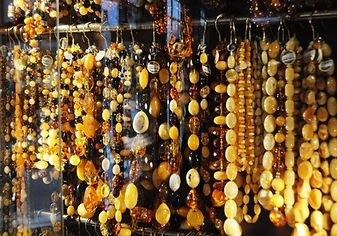AMBER
AMBER
Amber is a fossilized fossil resin, a hardened resin of the most ancient conifers of the Upper Cretaceous and Paleogene periods. It is also used in small quantities in pharmaceuticals and perfumery, in the food, chemical and electronic industries.

The use of amber by man has been known since ancient times. The ancient Egyptians used amber for both jewelry and mummification. Amber has been used since ancient times for the manufacture of all kinds of jewelry and household items. Amber was used to make not only wearable jewelry, but also practical items such as cigarette cases, ashtrays, boxes, chests and even watches. The famous Amber Room occupies a special place in art.

After the Second World War, the secrets of mastery of creating large amber items were mostly lost. The revival of these traditions in the Baltic countries took different paths.
Amber is a fragile material, its processing leads to a significant reduction in the primary size and weight of stones, which in turn leads to an increase in the cost of jewelry.
Currently, there are original processing technologies for imparting the desired color and texture to amber: clarification, heating, heating, chemical processing, grinding, cutting, stone carving and others. The pressed amber is also worth noting.
Interesting Facts
1. Amber is a gem, but not a gem.
It is not a mineral, but the fossilized resin of some ancient trees that took root 38-120 million years ago. Its appearance was facilitated by a critical change in the vegetation cover of the Earth.
Due to the change in climate from dry and hot to temperate, many new plants have appeared, but other types of vegetation have disappeared, including cicada, sago, and fern.
2. The world's largest amber storage facilities are located in the Baltic region.
3. According to the report of the Royal Society for the Development of Nature Knowledge, more than 105 tons of Baltic amber was mined in northern Europe, in places where forests were in the Paleogene period.
4. The world's largest amber is in the Amber Museum in Copenhagen. When they found him, the weight of the amber was about 80 kg.
5. There are more than 300 colors in which amber is painted.
The color of amber is not always yellow, red or orange. This gem can be white, green and blue.
6. For amber to be able to form, it takes millions of years and certain conditions for the burial of resin in forest soils.
Most tree resin is chemically unstable and will rot over time instead of hardening.
7. To distinguish real amber from fake, you just need to immerse the item in salt water. Natural amber immersed in a glass of water and 2-3 tbsp. spoons of salt, will float, and the fake will go to the bottom.
Lithuanian amber - a symbol and a jewel
The resin of fossilized trees of antiquity is called “Lithuanian gold”, or amber. The Baltic amber is over 44 million years old! Even in the tombs of the pharaohs, amber items were found - household items and ornaments. In the Middle Ages, the Lithuanian nobility gave amber to foreign ambassadors and distinguished guests. From time immemorial, unusual, magical properties were attributed to this stone - maintaining firmness of mind, healing from many diseases and strengthening friendship. Amber has become a kind of symbol for Lithuania, with the help of which this state loudly declares itself. It is not for nothing that practically in all spheres - commerce (beer and cookies), television (serials and programs), in the names of music festivals and hotel complexes, the word "amber" is invariably present.
Many legends are associated with amber, sea, fishermen and, of course, love. Jurate and Kastytis were madly in love with each other, but Jurate was a sea queen and lived in an amber palace, and Kastytis was an ordinary fisherman. They met every night on the beach. But one day the god Perkunas tracked them down and decided to punish the sea queen. He threw his lightning into the ocean waters, and the amber palace collapsed. At that very second, Queen Jurate fell lifeless into the arms of her beloved. Since then, in a strong storm, the voice of a fisherman, full of despair, is heard mourning his beloved, and the cold Baltic Sea throws pieces of the palace onto the shore.
The Palanga Amber Museum is located in the former estate of Prince Tyshkevich, built in 1897 in the center of the Botanical Garden. The Amber Museum was opened in 1963 and is considered the main exhibition center in Lithuania. Fifteen exhibition halls offer four and a half thousand amber items, the total number of items is 28 thousand. The overwhelming majority of these stones are so-called "inclusions", that is, they contain pieces of plants and insects inside them. These are the most valuable exhibits. The main value of the amber collection in Palanga is "Amber Sun", a stone weighing almost 4 kg (by the way, they tried to steal it twice).

Studying the amber resources of the state, Lithuanian scientists claim that the largest amount of amber is thrown out by the Baltic Sea in the area of the village of Karkle, which is located on the territory of the Seaside Regional Park. There is an exhibition open to all comers telling about the history and properties of amber. Today in the Karkle region, amber is mined by about 30 catchers.
Lithuanian amber is fundamentally different from stones mined in other regions, for example, in Latvia. It is color, shape, and play of light.

WE INVITE ALL WHO WISHES
TO TAKE PART IN THE QUIZ
